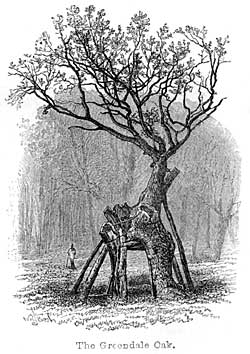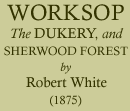< Previous | Contents | Next >
Welbeck Park has always been famous for its oaks. The following letter from Sir Christopher Wren, which is still preserved at Welbeck Abbey, shews that some of the timber used in building St. Paul’s Cathedral was obtained from this park:
For Mr. Richard Neale,
Steward to His Grace the Duke of Newcastle at Welbeck.
Lond.: April 4th, 1695.
Sir,—Having in my letter of June 23, 1693, signified to you a particular of all the scantlings of the Timber wee might use in the roofe of St. Paules, that His Graces noble benefaction might be as useful as may be to the worke, and understanding that what is already designed is none of the Great beams, wch is what wee are most solicitous for, and being given also to understand that we must expect this season but Ten of the great Trees: I presume once more to acquaint you with the scantlings of the great Beames to prevent mistake.
47 feet long, 13 inches and 14 inches at the small end, growing timber, this scantling to hold die square as near as can be without sap.
Mr. Longland our chiefe carpenter will be sent down this season to take care of this concerne, and the timber brought down to Bawtrey, whom I desire you to converse with in particulars wch at this distance I can hardly determine, and beseech you to present with all advantage our utmost sence of his Graces favor, of wch also I am very sensible as becomes
Your humble servant
CER. WREN.
The park abounds in extensive woods and remarkable trees. The latter were described by Major Rooke, in 1790, in his "Descriptions and Sketches of remarkable Oaks in Welbeck Park." The principal ones are as follow:
The "Porter Oaks," so called from there having been a gateway between them. The height of one is about 100 feet, and its circumference about 38 feet; the other is about 90 feet high, and about 34 feet in circumference.
Then there is the "Seven Sisters," an oak so called ‘from its having had seven trunks issuing from one root, in a perpendicular direction, to the height of about 88 or 90 feet; the circumference at the bottom is about 30 feet. Several of these stems were long since blown down.
The "Duke’s Walking Stick," which formerly stood in this park, was a fine oak, perhaps unmatched by any other in the kingdom for height and straightness. It was 111 ft. 6in. high, contained about 440 feet of solid timber, and its weight was estimated at 11 tons. There is now a "Young Oak Walking Stick," of 129 years’ growth, in the plantation near the Abbey.
This tree is as straight as an arrow, and about 100 feet high, and 70 feet to the branches.
"Greendale Oak" – the "Methuselah of trees – unquestionably the most remarkable tree in this fine domain. In 1724 an opening was made through this tree, capable of allowing a carriage, or three horsemen abreast, to pass through. The Major gives the following as the dimensions of the tree at that time
"The circumference of the trunk above the arch, 35 ft. 3in.; height of the arch, 10 ft. 3 in.; width about the middle, 6ft. 3 in.; height to the top branch, 54 ft." The age of this tree must, of course, be speculation. Major Rooke said, in 1790, it is "thought to be above seven hundred years old ; and Throsby, in his edition of Thoroton’s "Nottinghamshire," 1797, says it "is supposed to be upwards of 1500 years old." It is now planked diagonally and otherwise supported; yet, notwithstanding its decrepitude, its green boughs spread over a diameter of about 45 feet.
In 1727 the Countess of Oxford had a cabinet made of the oak, taken from the heart of this tree in making the cavity named above. The cabinet is now at Welbeck, and contains in-laid representations of the tree and a former Duke of Portland driving an old-fashioned carriage and six horses through the opening, with the following quotation from Ovid’s "Metamorphosis :"
"Saepe sub haec Dryades festas duxere choreas;
Saepe etiam manibus nexis ex ordine trunci
circuiere modum mensuraque roboris ulnas
Quinque ter implebat, nec non et cetera lento
Silva sub hac, Sylva quanto jacet herba sub omni."
Which may be thus rendered:
"Oft did the dryads lead the festive dance
Beneath his shade, or hand in hand enclose
The orbit of his trunk, full fifteen yards:
Whose head above his fellow of the grove
Doth tower, as these above the sward beneath."
And also the following lines from Chaucer :
‘Lo, the Oke ! that hath so long a norishing
Fro the time that it ginneth first to spring,
And hath so long a life, as we may see,
Yet, at the last, wasted is the tree."

